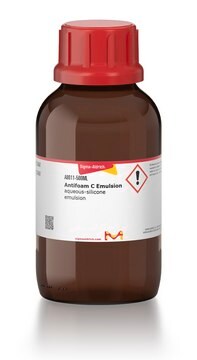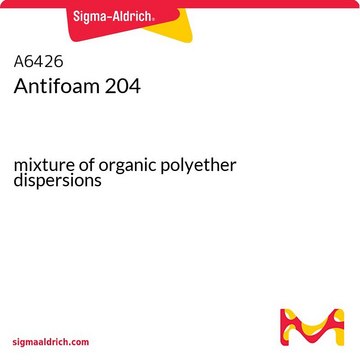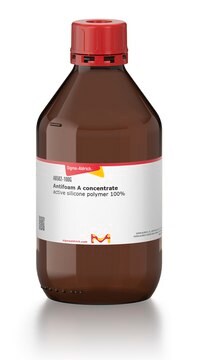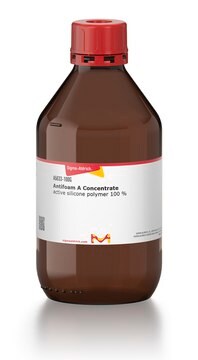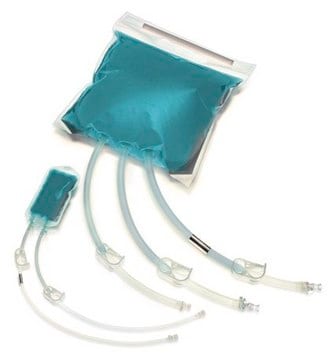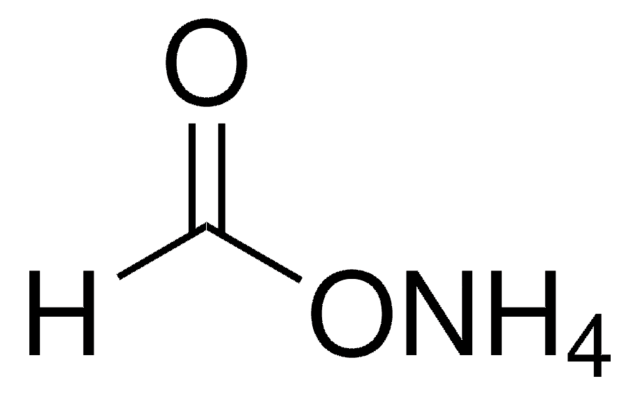A8582
Antifoam SE-15
aqueous emulsion for bacterial and mammalian systems
Synonim(y):
środek przeciwpieniący na bazie silikonu
Zaloguj sięWyświetlanie cen organizacyjnych i kontraktowych
About This Item
Kod UNSPSC:
12161901
NACRES:
NA.85
Polecane produkty
Poziom jakości
Formularz
emulsion (aqueous)
stężenie
10% (active silicon)
metody
cell culture | hybridoma: suitable
rozpuszczalność
H2O: soluble (effective hot or cold.)
gęstość
1.0 g/mL at 25 °C
Zastosowanie
microbiology
temp. przechowywania
room temp
przydatność
(Mammalian (suspension))
bacteria (fermentation)
Opis ogólny
Antifoam SE-15 is a silicone-based product used to prevent or minimize foaming in both microbial fermentation systems and mammalian suspension cultures. Control of foaming minimizes damage to the cells, resulting in increased protein/antibody production.
Zastosowanie
Antifoam SE-15 has been used:
- in the preparation of ramified rolling circle amplification (RAM) amplification buffer.
- to find its effects on cell viability, virus infectivity and PCR (polymerase chain reaction) performance.
- as a constituent of phosphate-buffered saline (PBS) for the determination of total antioxidant status (TAOS) by 2,2′-azino-bis(3-ethylbenzothiazoline-6-sulfonic acid (ABTS) assay.
- as a component of autoinduction expression culture.
- as a component of cyclic adenosine monophosphate (cAMP) detection buffer.
Cechy i korzyści
- Controls foaming in microbial culture flasks or fermentations
- Non-toxic to the culture medium
- Can be pumped to fermenter on an as-needed basis
Komponenty
Antifoam SE-15 is an aqueous emulsion containing 10% active silicon and non-ionic emulsifiers .
Uwaga dotycząca przygotowania
Antifoam SE-15 can be pre-diluted with 3-10 parts of cool water to aid in dispersion. Pre-diluted
suspensions should be used immediately.
suspensions should be used immediately.
Ta strona może zawierać tekst przetłumaczony maszynowo.
produkt powiązany
Hasło ostrzegawcze
Warning
Zwroty wskazujące rodzaj zagrożenia
Zwroty wskazujące środki ostrożności
Klasyfikacja zagrożeń
Eye Irrit. 2 - STOT RE 2 Inhalation
Organy docelowe
Lungs
Klasa zagrożenia wodnego (WGK)
WGK 1
Wybierz jedną z najnowszych wersji:
Masz już ten produkt?
Dokumenty związane z niedawno zakupionymi produktami zostały zamieszczone w Bibliotece dokumentów.
Klienci oglądali również te produkty
Dario A Vitturi et al.
American journal of physiology. Heart and circulatory physiology, 296(5), H1398-H1407 (2009-03-17)
Allosteric regulation of nitrite reduction by deoxyhemoglobin has been proposed to mediate nitric oxide (NO) formation during hypoxia. Nitrite is predominantly an anion at physiological pH, raising questions about the mechanism by which it enters the red blood cell (RBC)
Detection of nucleic acid targets using ramified rolling circle DNA amplification: a single nucleotide polymorphism assay model
Smith J H and Beals T P
PLoS ONE, 8(5), e65053-e65053 (2013)
Elisa Binda et al.
BMC biotechnology, 13, 24-24 (2013-03-19)
VanYn, encoded by the dbv7 gene (also known as vanYn) of the biosynthetic cluster devoted to A40926 production, is a novel protein involved in the mechanism of self-resistance in Nonomuraea sp. ATCC 39727. This filamentous actinomycete is an uncommon microorganism
James H Smith et al.
PloS one, 8(5), e65053-e65053 (2013-06-01)
Isothermal amplification methods provide alternatives to PCR that may be preferable for some nucleic acid target detection tasks. Among current isothermal target detection methods, ramified rolling circle amplification (RAM) of single-stranded DNA circles that are formed by ligation of linear
Jiayi Jin et al.
Insect biochemistry and molecular biology, 118, 103310-103310 (2019-12-25)
Many arthropod venom peptides have potential as bioinsecticides, drug leads, and pharmacological tools due to their specific neuromodulatory functions. Assassin flies (Asilidae) are a family of predaceous dipterans that produce a unique and complex peptide-rich venom for killing insect prey
Nasz zespół naukowców ma doświadczenie we wszystkich obszarach badań, w tym w naukach przyrodniczych, materiałoznawstwie, syntezie chemicznej, chromatografii, analityce i wielu innych dziedzinach.
Skontaktuj się z zespołem ds. pomocy technicznej